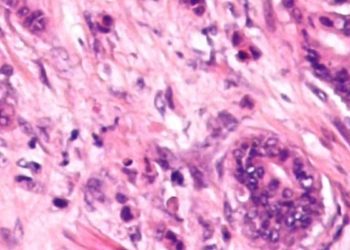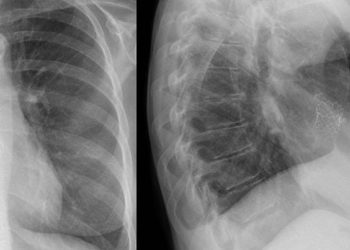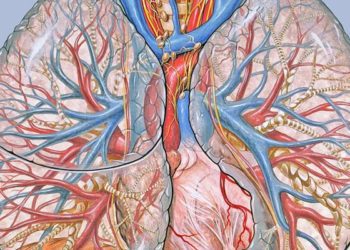Decreasing incidence of heart failure observed in Ontario, Canada
Image: CC/JHeilman. Pulmonary edema in heart failure.
Key findings:
- This study noted a substantial decrease in the incidence of heart failure in Ontario during the study period, with the largest declines in the oldest age group
- There was a modest improvement observed in 1-year mortality but results were inconsistent between inpatient and outpatient groups
Primer: Heart failure has been associated with high morbidity and mortality rates and is a significant burden on health care systems. Cardiovascular disease is a leading cause of death globally and heart failure specifically is a common cause of hospital admission. Heart failure is characterized by dyspnea and fatigue caused by reduced ability of the heart to deliver sufficient oxygen to tissues.
Trends in the incidence of heart failure and other cardiovascular events have been changing over time with rapidly increasing rates observed in the 1990s and more recently, no change or declines in hospital admissions due to heart failure. This large, population-based cohort study contributes to the body of evidence suggesting a decrease in incidence of heart failure.
For further reading regarding, please see the following studies:
- Roger VL, Weston SA, Redfield MM, et al. Trends in heart failure incidence and survival in a community-based population. JAMA 2004;292(3):344-350.
- Tu JV, Nardi L, Fang J, et al. National trends in rates of death and hospital admissions related to acute myocardial infarction, heart failure and stroke, 1994-2004. CMAJ 2009;180(13):E118-125.
This [population-based] study: This population-based study reviewed patients who were diagnosed with heart failure for the first time between April 1, 1997 and March 31, 2008. Inpatient and outpatient data were collected from the Canadian Institute for Health Information’s (CIHI) Discharge Abstract Database and the Ontario Health Insurance Plan (OHIP) physicians claims database, respectively. A heart failure event was considered as 1 documented admission for heart failure alone, or 1 outpatient claim for heart failure followed by at least 1 additional outpatient heart failure claim within 1 year, using the 2-claim method.
This study identified 419,551 incident cases of heart failure in Ontario from 1997-2007. The age- and sex-standardized incidence of heart failure significantly decreased in both inpatient and outpatient settings. The 1-year risk-adjusted mortality significantly decreased among all patients, with a significant decrease among outpatients and a nonsignificant decrease among inpatients. Both the 1-year risk-adjusted rate of readmission for heart failure and the 1-year risk-adjusted all-cause readmission rate decreased significantly.
In sum: The results of this study were promising, showing a substantial decrease in the incidence of heart failure in Ontario between 1997 and 2007; however, only modest improvement was observed in prognosis for patients with heart failure. Although the 2-claim method improved the specificity of case selection, this may have led to an underestimate of the incidence of heart failure. A strength of the investigation was the inclusion of outpatients, since most previous studies have not included ambulatory data and this group accounts for roughly half of new cases. This is also the largest and most recent population-based study showing a decreasing trend in the incidence of heart failure. Possible explanations for the decline include declines in cases of ischemic heart disease (i.e., a leading cause of heart failure) and improved prevention of ischemic heart disease by addressing risk factors such as smoking and hypertension.
Written by [AdC] and [AC]
© 2012 2minutemedicine.com. All rights reserved. No works may be reproduced without written consent from 2minutemedicine.com. DISCLAIMER: Posts are not medical advice and are not intended as such. Please see a healthcare professional if you seek medical advice.





